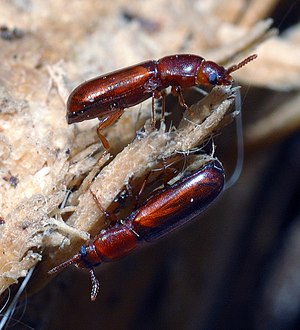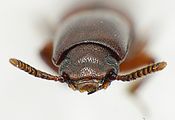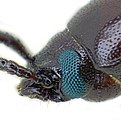Corticeus unicolor
| Corticeus unicolor | ||||||||||||
|---|---|---|---|---|---|---|---|---|---|---|---|---|

Corticeus unicolor |
||||||||||||
| Systematics | ||||||||||||
|
||||||||||||
| Scientific name | ||||||||||||
| Corticeus unicolor | ||||||||||||
| ( Piller & Mitterpacher , 1783) |
  
|
||
| Fig. 1–3: Beetles from above, the side and below | ||

|

|
|
| Fig. 4: Beetle from the front | Fig. 5: Eye tinted blue | Fig. 6: Larva |
Corticeus unicolor , synonymous with Hypophloeus unicolor and Hypophloeus castaneus , is a beetle from the family of black beetles (Tenebrionidae) and the subfamily Diaperinae . There are several similar types .
The species name unicolor ( lat. Monochrome) only differentiates the beetle from the two-colored Corticeus bicolor , but not from other monochrome species of the genus . The generic name Corticeus (Latin cortex = bark) and Hypophloeus (from ancient Greek ὑπὸ "hypó" for "under" and φλοιός "phloiós" for "bark") allude to the habitat under the bark.
The beetle is not uncommon in Central Europe, but because of its small size and hidden way of life, it receives little attention. Since it feeds largely on bark beetles (Scolytinae), it is counted among the useful insects.
Characteristics of the beetle
The narrow, cylindrical beetle is five to seven millimeters long, but is only about one and a half millimeters wide. It is bald and - as the synonymous epithet castaneus (maroon) suggests - dark red-brown in color. The antennae and legs are a little paler.
The head is much wider than it is long and coarse and densely punctured . It is indented transversely between the eyes at the level of the front edge of the eye (Fig. 4). The upper lip is separated from the head shield by a synovium . This synovium is slightly shinier than the surrounding skeletal parts and deepened in a groove-like manner perpendicular to the body axis (Fig. 4). The tip of the upper jaw is divided. The end member of the lip probe is egg-shaped, the end member of the jaw probe is long egg-shaped. The relatively flat compound eyes are three times as wide as they are long. They extend from the top of the head over the side to the bottom of the head up to the level of the base of the lower jaw (Fig. 5). The eleven-limbed antennae do not reach the rear edge of the pronotum and are cup-shaped and wider than long from the fourth limb, with the exception of the rounded end limb.
The matt, glossy pronotum is only slightly wider than the head, hardly narrower than the elytra and significantly longer than wide. The sides of the pronotum are almost parallel, the side edge is canted, as is the straight base. The puncture of the pronotum consists of clear, elongated points that are irregular and less dense than the points on the head. The Prosternum is seamlessly fused with the side pieces of the front chest.
The matt elytra are almost three times as long as they are wide together. They have poorly developed rows of points. The spaces in between are very finely dotted. The shoulder bumps are protruding, behind the wing cover sides run parallel. They end together in a semicircular rounded shape. However, they are towered over by the end of the horny pygidium.
The shiny underside is also clearly dotted. The front, middle and rear hips are clearly separated (Fig. 3). The rails are slightly widened towards the rear and ciliate on the inside. The tarsi of the hind legs are four-limbed, the remaining five-limbed. They are short and not lobed, the claw member is straight. The last four abdominal sternites show a deep, wide longitudinal furrow on the side. Between the third and fourth and between the fourth and fifth abdominal sternite, a synovium broad in the middle is visible.
larva
The larvae of the genus (Fig. 5) have a broadly rounded, strongly chitinous, brownish anal segment with a sharply defined edge. The side edges of the segments are covered with individual, very long bristles.
biology
The warmth-loving beetle can be found under the bark of various deciduous tree species. It belongs to the rotten wood dwellers and, like its larvae, hunts their larvae in the duct system of various wood dwelling beetles. Called Borken- , rodents and shipyard beetle . It prefers to colonize trees on the edges of mixed forests, especially fungal bark of beeches and oaks that are infested by bark beetles , more north often birches , in mountainous locations also conifers . The species is also found in tree sponges on beech and birch trees. The beetles come outside at night and can be found gregariously feeding on tree fungi. In England they were observed from April to October, with the most common in September.
distribution
The species is common in almost all of Europe, except in the extreme west and east. In the west it is absent on the Iberian Peninsula and in Ireland , the eastern limit of distribution runs bypassing Finland from Scandinavia via the Baltic States , Poland , Slovakia , Hungary , Serbia , Bulgaria and Greece . There are no reports from Slovenia , Switzerland , the Netherlands and the Kaliningrad region . The species is newly reported from Macedonia . Outside of Europe, the beetle was found in pine plantations in Israel .
literature
- Edmund Reitter : Fauna Germanica, the beetles of the German Empire. III. Volume, KG Lutz 'publishing house, Stuttgart 1911.
- Heinz joy , Karl Wilhelm Harde , Gustav Adolf Lohse (ed.): The beetles of Central Europe . tape 8 . Teredilia Heteromera Lamellicornia . Elsevier, Spektrum, Akademischer Verlag, Munich 1969, ISBN 3-8274-0682-X .
- Klaus Koch : The Beetles of Central Europe Ecology . 1st edition. tape 2 . Goecke & Evers, Krefeld 1989, ISBN 3-87263-040-7 .
- Gustav Jäger (Ed.): CG Calwer's Käferbuch. K. Thienemanns, Stuttgart 1876, 3rd edition.
Individual evidence
- ↑ Edmund Reitter : Fauna Germanica, the beetles of the German Empire III. Volume, KGLutz 'Verlag, Stuttgart 1911, p. 341.
- ↑ a b Hypophloeus unicolor in Fauna Europaea. Retrieved November 30, 2012
- ↑ Sigmund Schenkling: Explanation of the scientific beetle names (kind).
- ↑ Sigmund Schenkling: Explanation of the scientific beetle names (genus).
- ↑ R. Korschefsky: Determination table of the best-known German tenebrionid and alleculid larvae . Work physiol. applied ent. Berlin-Dahlem, Volume 10, 1943, Kr. 1. online (PDF).
- ↑ Wolfgang Willner: Taschenlexikon der Käfer Mitteleuropas . 1st edition. Quelle & Meyer, Wiebelsheim 2013, ISBN 978-3-494-01451-7 .
- ↑ Klaus Koch : Die Käfer Mitteleuropas Ökologie . 1st edition. tape 2 . Goecke & Evers, Krefeld 1989, ISBN 3-87263-040-7 .
- ↑ Alan Brown: Notable Coleoptera found in the Kidderminster area 2008-2011. Worcestershire Biological Records Center, Worcestershire Record 31, Nov. 2011 ISSN 1475-9616 wbrc.org.uk (PDF).
- ↑ Borislav Guéorguiev, Rostislav Bekchiev, Evgeni Chehlarov, Slavcho Hristovski, Dana Preliќ, Aleksandra Cvetkovska-Gorgievska: New Coleoptera species from Republic of Macedonia. Acta Zoologica Bulgarica 62 (3) 2010 pp. 363-3365.
- ↑ Z Mendel, H Podoler, H Livne: Interactions between Aulonium ruficorne (Coleoptera, Colydiidae) and other natural enemies of Bark beetles (Coleoptera, Scolytidae) Springer, Entomophaga 35 (1) 1990 pp. 99-105.